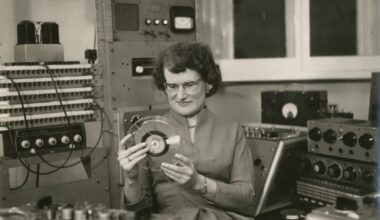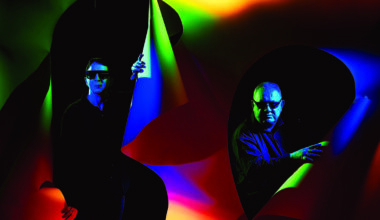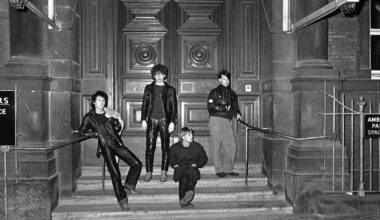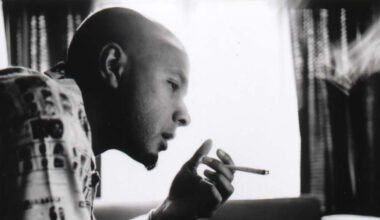Take Japanese noiseniks-turned-minimalists Nisennenmondai. Add a big dollop of On-U production wizard Adrian Sherwood. The result is ‘#N/A’, an album where human frailty meets precision engineering
Three Japanese women step onto a stage. One of them picks up a bass, another sits at a minimal drum kit, and a third with a guitar around her neck starts playing a series of patterns which are picked up, repeated and filtered by some of the dozen or so devices she has wired together on a table in front of her. The hi-hats join the pattern, scarily precise, then the bass starts to pulse. All three players are locked in, focused, inward.
The performance has all the cleanliness and precision of a robot factory line spot welding cars. It includes the thrilling occasional sprays of dancing hot sparks and it’s just as mesmerising. At times, like on the bouncy ‘#3’, it’s reminiscent of those Conny Plank and Mani Neumeier albums, like ‘Zero Set’.
This is Nisennenmondai, formed in Japan in 1999, much beloved by the post-rock cognoscenti for their outré approach to the idea of what a band should be. Take the group’s first EP, ‘Sorede Souzousuru Neji’ (‘So Imagine The Screw’). Three of the five tracks are named after bands: ‘Sonic Youth’, ‘This Heat’, ‘Pop Group’. Much like the work of these artists, the music is a spectacular collision of distortion and noise.
“I first started playing the guitar when I joined a music club at university,” explains Masako Takada, the most forthcoming of the trio. “When I first heard the senior students play ‘noise’ music, alternative and instrumental music which was unfamiliar to me at the time, I thought it was so cool, even though I didn’t really understand it. Also with noise music, I thought I could give it a go myself, even if I couldn’t play any instrument. From then on, I started making noisy instrumental music.”
Once she’d taken the plunge, Takada quickly encountered The Velvet Underground and Silver Apples. When she started playing gigs, people would ask her if she was into the likes of Can and Neu! and PiL. Which, at the time, she wasn’t.
“I was listening to Gong, but then I discovered krautrock. As the band progressed and started incorporating repetitive loops, I became more aware of techno and disco… and here we are. I’ve not listened to a lot of music, but I’ve picked up influences from different genres at crucial points.”
Nisennenmondai sit at that nexus between guitar noise and electronica, a magical mystery zone where the impulsive explorer plays around with sound and form, looking for new textures and moods in the kinds of places that have attracted everyone from Can to Chris & Cosey to Factory Floor over the years, places where you’ll also find the current crop of motorik freaks.
Ever since their noisy early days, Nisennenmondai (the name refers to the Y2K bug – remember that, technophobia fans?) have been on a mission of reduction. Drummer Sayaka Himeno, once very keen on splashing around an array of cymbals, now plays with just kick, snare and hats, and with a discipline that borders on the supernatural (“You need to practice daily and concentrate very hard,” is her matter-of-fact answer when I ask her how she does it). Yuri Zaikawa’s basslines, which previously riffed and provided melody, are now either luscious slabs of slowly moving pure tone or single note pulses held for 10 minutes or more at a time.
“A lot of our music has single notes, yet structured without any break, so I play standing straight and still in order not to play a wrong note,” says Zaikawa. “I don’t really do classic basslines and riffs, but you can’t get away with making mistakes. It’s challenging to shut down every single emotion and play a single note mechanically.”
Masako Takada’s guitar meanwhile no longer slashes and burns with post-punk fury, but is instead a series of loops and textures, layered and filtered, the work of a technician. And so the roomy messiness of Nisennenmondai’s initial work, all snare rattle, earth buzz and beery rehearsal room ambience, has mutated into clean, regimented minimalism on the group’s new album, ‘#N/A’.
One of the reasons for this is the fact that On-U Sound man Adrian Sherwood, the UK’s very own producer of legend, is at the controls. That clunky but hashtag-hip album title means ‘Nisennenmondai With Adrian Sherwood’, as well as suggesting that this music fits no category; “not applicable”. Sherwood was introduced to the band by Paul Smith from Blast First Records.
“He used to work with Nisennenmondai and was chatting about them to me,” says Sherwood.
“Lots of friends who were interested in alternative stuff, any time that Japan was mentioned, they would ask if I’d heard them. I checked them out and thought they seemed really interesting. They have a real intense uniqueness about them.”

He was impressed when he saw them play, but less so when he heard their albums.
“When I got the chance to work with them I thought, ‘Yes please, that would be great’,” he continues. “I realised they hadn’t really made a good studio album, so I studied them live and thought about a way of going about making an interesting studio record.”
Sherwood describes his contribution to ‘#N/A’ as emphasising the “sonic intensity”. He wanted to make sure the album was recorded well in the first place, clean signal paths and all that. When he was satisfied that the band was happy and feeling creative, he travelled to Tokyo and the whole thing was done and dusted in two days.
“We did a couple of overdubs to sparkle it up, but I kept it very simple. You don’t want to over-produce something like that, but at the same time you’ve got to add that little extra 10 per cent, which I think is the job of a producer. I didn’t want to go On-U crazy with it either, so I made a conscious effort to use a similar set of sounds. I only let myself go on a couple of the extra tunes we did.”
The two extra tracks were recorded live at the Tokyo club Unit, with Sherwood on the mix.
“I was dubbing the shit out of it,” he laughs. “The fan base at that gig was an On-U crowd, because it was my night in Tokyo I invited them to play at, and I think a lot of the Japanese people were seeing them for the first time. It kind of works both ways. People realise I do more than just reggae-flavoured stuff and the band made a few fans that night because they were brilliant.”
‘#N/A’ is an album that rewards close listening, revealing both Nisennenmondai’s and Adrian Sherwood’s attention to detail, from the slight scratches of sound and subtle atmospheres that emerge out of the rhythmic precision, to the enveloping warmth of the bass (you’d expect as much from Sherwood’s bass shaping chops), to the overall sense of structure that isn’t entirely obvious on a cursory listen. Themes weave in and out, but they might be metallic clankings rather than melodies, and there’s always an airy sense of space.
“I worked on the tone,” says Sherwood. “I used the same approach as I do with reggae. I always work on getting the tonality right, that’s what I learned from all my years working with the Jamaican producers, and I’ve applied that to everything I’ve ever done. Get the right EQ on the hats, on the foot drum, as a picture within that band. I tried to make a nice experience that captured them and then I added my tonal things to it.”
What do the group think of Sherwood’s contribution?
“We worked very well together, I think,” says Takada. “We met him for the first time in the recording studio and I was struck by his gentlemanly vibes. I was worried at first, but when he put a live dub and effects on a session we’d recorded, it sounded interesting. It felt like we shared something in common, so I thought everything was going to be alright with him.”
And their verdict on the end result?
“This album is completely different from our previous records,” replies Takada. “In terms of tracks, when we do it ourselves, we get a direction we want to follow, then we compose, then we record. On ‘#N/A’, apart from a couple of tracks, we just recorded our jam sessions. We also added some stuff afterwards on top of what’s already been recorded, following Adrian’s suggestions.
“We usually communicate thoroughly with our engineer during mixing and mastering, so we can achieve the music we think is ideal, whereas this album was shaped by Adrian’s skill and keen sense of sound. Because it contains a lot of objective perspectives that enabled us to show our different side, it turned into a very interesting work as a whole.”
And taken as a whole, with a pair of headphones clamped onto your skull, ‘#N/A’ creates a feedback loop in your brain that becomes almost meditative.
“When I’m playing well, I feel like I’m at one with nature,” declares Takada.
“When various elements are working well together and I’m concentrating, I feel like I’m in a trance,” adds Yuri Zaikawa.
Nisennenmondai might have made themselves sound like a machine, but their special appeal lies in the fact that they are not using machinery to generate their beats or engineer their precision. Like mid-period Kraftwerk – an odd comparison for sure, but bear with me – they play with the idea of a machine, but the human frailty at the heart of what they do is what makes it work. You hear the slips on the hi-hats and the fret buzzes, tiny but instantly recognisably natural touches. None of this is quantised. As if to prove the point, their most abiding memories of touring the world are entirely human. They’re also particularly Japanese.
“They had natural hot spring water coming out of the shower in a hotel in Iceland,” says Sayaka Himeno. “My skin felt so smooth and I felt so relaxed. I was overjoyed by the power of hot springs!”
“I love it when people come and listen to Nisennenmondai in the middle of nowhere and then we bump into a fan walking around in a Nisennenmondai T-shirt in town the next day,” smiles Zaikawa. “It’s amazing to think that we are patiently making music in a corner of Tokyo but we’re connected to people from very far away places.”
‘#N/A’ is out on On-U Sound






